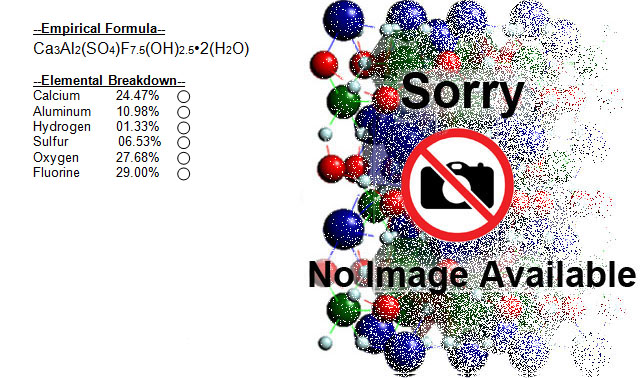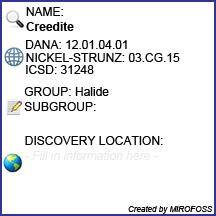

| Mineral Name | Creedite |
| First Discovered | 1916 |
| Nickel-Strunz Classification | 03.CG.15 |
| Dana Classification | 12.01.04.01 |
| ICSD | 31248 |
| Mineral Group | Halides |

| Cleavage | Perfect |
| Colour(s) | Colourless, Violet, Orange, White |
| Specific Gravity | 2.71 |
| Diaphaneity | Transparent to Translucent |
| Fracture | Conchoidal |
| Mohs Hardness | 3.5 |
| Luminescence | Non-fluorescent |
| Luster | Vitreous |
| Streak | White |
| Habit(s) | Granular to Prismatic to Radial |
| Radioactivity | Non-radioactive |
| Magnetism | Non-magnetic |

No known health risks have been associated with creedite. However ingestion of creedite, as with other naturally occurring minerals, is not recommended.

The following image shows the Elemental breakdown of the mineral creedite along with the mineral crystal structure.


| Crystal System | Monoclinic |  |
| Class | Prismatic | |
| Axial Ratios | a : b : c = 1.5046 : 1 : 1.655 | |
| Optical Data Type | Biaxial (-) | |
| Pleochroism (x) | None | |
| Pleochroism (y) | None | |
| RL Values | nα = 1.461 nβ = 1.478 nγ = 1.485 | |
| 2V | Measured: 57° , Calculated: 54° | |
| Max Birefringence | δ = 0.024 (See colour chart at right) |  |
| Surface Relief | Moderate | |
| Dispersion | r > v strong | |
| Notes: | ||

Creedite can be referenced in certain current and historical texts under the following name:
The mineral creedite can be translated into the following select languages:
| Arabic | Bulgarian | Chinese (Sim) | 铬铅矿 | ||
| Croatian | Czech | Danish | |||
| Dutch | Creediet | Esperanto | Estonian | ||
| Finnish | French | German | Creedit | ||
| Greek | Hebrew | Hungarian | |||
| Italian | Japanese | クルイダイト | Korean | 크랻아읻 | |
| Latin | Lithuanian | Norwegian | |||
| Persian | Polish | Portuguese | |||
| Romanian | Russian | Кридит | Slovak | ||
| Spanish | Creedita | Swedish | Tagalog | ||
| Turkish | Kredit | Ukrainian | Крідіта | Vietnamese |


 |
The MIROFOSS database offers free printable geological identification tags for personal and non-profit use. These tags can be used to properly identify mineral samples in your collection. -Click here- to download a full size jpeg image for an aluminum identification tag; which can be printed on paper or used with a plastic laser printer. |
 |
What's this? What can I do with it? |

| Chemical Composistion | Foshag (1922) Proceedings of the U.S. National Museum: 59: 419. |
| History | American Mineralogist (1932): 17: 75. |
| History | Palache, C., Berman, H., & Frondel, C. (1951), The System of Mineralogy of James Dwight Dana and Edward Salisbury Dana, Yale University 1837-1892, Volume II: Halides, Nitrates, Borates, Carbonates, Sulfates, Phosphates, Arsenates, Tungstates, Molybdates, Etc. John Wiley and Sons, Inc., New York, 7th edition, revised and enlarged: 129-130. |
| History | Robert Cook (2008) Connoisseur's Choice Creedite Cresson Mine, Cripple Creek, Teller County, Colorado. Rocks & Minerals 81:5 422-426 |
| Geograpcial Data | Mindat.org. Retrieved on 2012-06-18 |
| Physical Identification | Webmineral.com. Retrieved on 2012-06-18. |
| June 24, 2014 | The last time this page was updated |
| ©2017 MIROFOSS™ Foundation | |
 |